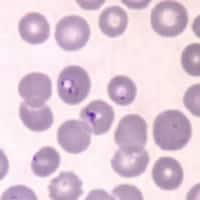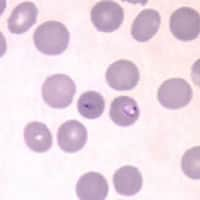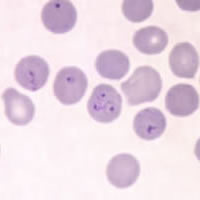
Monthy Case Studies - 2001
Case #51 - January, 2001
A 42-year-old landscape architect offered to help his 16-year-old daughter with her science fair project. She wanted to demonstrate some of the cellular components of human blood. Her father used a sewing needle, sterilized with rubbing alcohol, to prick his finger and then placed one drop of blood on two glass slides. She made thin blood films using a technique she saw on the DPDx Web site. She took the dried blood films to class and followed the procedure for Giemsa staining she obtained from the same Web site. While examining one of the stained blood films, she saw several objects that she could not identify (Figures A, B, and C). Her father was not ill at the time and had not been for several months. What is your diagnosis? Based on what criteria?

Figure A

Figure B

Figure C
Answer to Case #51
This was a case of babesiosis caused by Babesia sp. Diagnostic features observed were:
- normal-sized infected red blood cells.
- the presence of only ring-stage parasites.
- no evidence of pigment in older rings (such as in a malaria infection).
- pleomorphic rings.
Sometimes patients with Babesia infections are asymptomatic or can have mild, vague symptoms, such as low-grade fever, that they do not realize they have a parasitic infection. This particular case was interesting because the infection was discovered accidentally by the patient's daughter. The biology teacher was not sure what the objects were, but recommended that the father see a doctor.
One may have noticed the monochromatic staining of this blood smear which indicates that the pH of the stain was probably not the recommended 7.2. This demonstrates the need for quality control in diagnostic laboratories so that the most accurate diagnosis can be made on specimens.
More on: Babesiosis
Images presented in the monthly case studies are from specimens submitted for diagnosis or archiving. On rare occasions, clinical histories given may be partly fictitious.
 ShareCompartir
ShareCompartir


